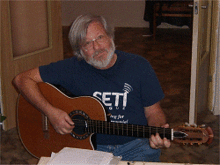- H. Paul Shuch
-
Dr. H. Paul Shuch (May 23, 1946) is an American scientist and engineer who has coordinated radio amateurs to help in the search for extraterrestrial intelligence.
Contents
Overview
Shuch, an aerospace engineer and microwave technologist is believed by colleague Jack Unger to be the creator of the world's first commercial home satellite TV receiver.[1][2] A visiting professor at Lycoming College and the Heidelberg University of Applied Sciences, Shuch continues to volunteer as the Executive Director Emeritus of The SETI League, Inc. [1]. He has taught physics, astronomy, and engineering on various campuses for over three decades.
Shuch is a Vietnam-era Air Force veteran and active instrument flight instructor. He founded Microcomm Consulting [2] in 1975, where in 1978 he designed and produced a commercial home satellite TV receiver.[3][4]
Early life
Born Howard Paul Wakes in Chicago, Illinois, USA. Shuch later adopted the name of his stepfather, physicist Milton L. Shuch.
Shuch earned a B.S. in industrial technology from San Jose State University and a Ph.D. in engineering from the University of California, Berkeley. Upon completion of military service, he worked as an engineer for several Silicon Valley aerospace companies before commencing his academic career.
SETI Activities
Shuch first learned about SETI, the electromagnetic Search for ExtraTerrestrial Intelligence, from Nicholas Marshall, W6OLO, a Hungarian engineer with whom he served on the Board of Project OSCAR, builders of the world's first non-Government satellite. Nick introduced Paul to longtime SETI proponent Dr. Bernard M. "Barney" Oliver, then vice-president of Engineering at the Hewlett-Packard Company. Oliver in turn introduced Paul to SETI pioneers Frank Drake and Philip Morrison, who encouraged his continued interest and involvement in the development of SETI radio telescopes, as a spin-off from his design of early satellite TV receivers.
While in graduate school at the University of California, Berkeley, Shuch became acquainted with most of the members of the NASA SETI team in nearby Mountain View, CA. Many SETI pioneers had been affiliated with Berkeley, either as faculty members, students, or postdoctoral researchers, and a SETI-friendly environment (some have called it a 'SETI cabal') persisted there. Among Shuch's professors was the prominent radio astronomer William J. "Jack" Welch, a member of the National Academy of Science, who further encouraged Shuch's SETI activities. One of Shuch's classmates in Welch's radio telescope design course was Dan Werthimer, who went on to become chief scientist of the SETI@home distributed computing experiment.
When the NASA SETI program was cancelled by the US Congress in 1993, New Jersey industrialist Richard Factor established the nonprofit, membership-supported SETI League,[5] which he invited Shuch to head. Shuch became the organization's first Executive Director,[6] a position he now holds on an emeritus basis. He designed the hardware and protocols for, and remains Principal Investigator on, the SETI League's Project Argus [3] all-sky survey[7][8][9]
Shuch is principal investigator for the Invitation to ETI [10] [4], a web-based SETI experiment initiated by his colleague, Dr. Allen Tough. Along with Ivan Almar of the Konkoly Observatory, Budapest, Shuch developed the San Marino Scale [5],[11] an analytical tool for quantifying the significance of transmissions from Earth into Space.[12]
Honors and awards
- 1999 Fellow of the British Interplanetary Society
- 2007 Full Member of the International Academy of Astronautics
References
- ^ Ungar, Jack (2003). Deploying License-Free Wireless Wide-Area Networks. Cisco Press. pp. v. ISBN 1587050692. http://books.google.com/?id=TQwtK5JnT04C&pg=PR5&dq=%22H.+Paul+Shuch%22. Retrieved 2007-12-31.
- ^ Birkill, Steve (1997). "RWT and the History of TVRO". http://www.rwt.co.uk/old/rwthist.htm. Retrieved 2008-03-22.
- ^ Cooper, Robert B. (2006). Television's Pirates: Hiding Behind Your Picture Tube. pp. 386–387. ISBN 0-9777980-0-3.
- ^ Cooper, Robert B. (1982, October). "Coop on Basics: the TVRO Receiver". Coop's Satellite Digest: 8.
- ^ Clark, Andrew J.H. and David H. (1999). Aliens: can we make contact with extraterrestrial intelligence?. Fromm International. pp. 85. ISBN 0-88064-233-5.
- ^ Chown, Marcus (1997, 19 April). "The Alien Spotters". New Scientist: 28. http://www.newscientist.com/article/mg15420784.500-the-alien-spotters.html. Retrieved 2008-04-13.
- ^ Shostak, Seth (1998). Sharing the Universe. Berkeley Hills Books. pp. 168. ISBN 0-9653774-3-1.
- ^ Clark, Stuart (2000). Life On Other Worlds and How to Find It. Springer Praxis. pp. 138. ISBN 1-859233-097-X.
- ^ Darling, David. "Internet Encyclopedia of Science". http://www.daviddarling.info/encyclopedia/A/ArgusP.html. Retrieved 2008-05-01.
- ^ Feedback (2004, 18 December). "ET on the Internet". New Scientist: 76. http://www.newscientist.com/article/mg18424782.700-feedback.html. Retrieved 2008-04-13.
- ^ Hecht, Jeff; Paulshuch, H (2006, 24 October). "The San Marino Scale: A new analytical tool for assessing transmission risk". Acta Astronautica 60: 57. Bibcode 2007AcAau..60...57A. doi:10.1016/j.actaastro.2006.04.012. Lay summary – New Scientist.
- ^ Almar, Ivan, "Shouting in the jungle: the SETI transmission debate." Journal of the British Interplanetary Society 60(4):142-146, April 2007
External links
Categories:- American astronomers
- 1946 births
- Living people
- Amateur radio people
- Microwave technology
- SETI
- University of California, Berkeley alumni
Wikimedia Foundation. 2010.

